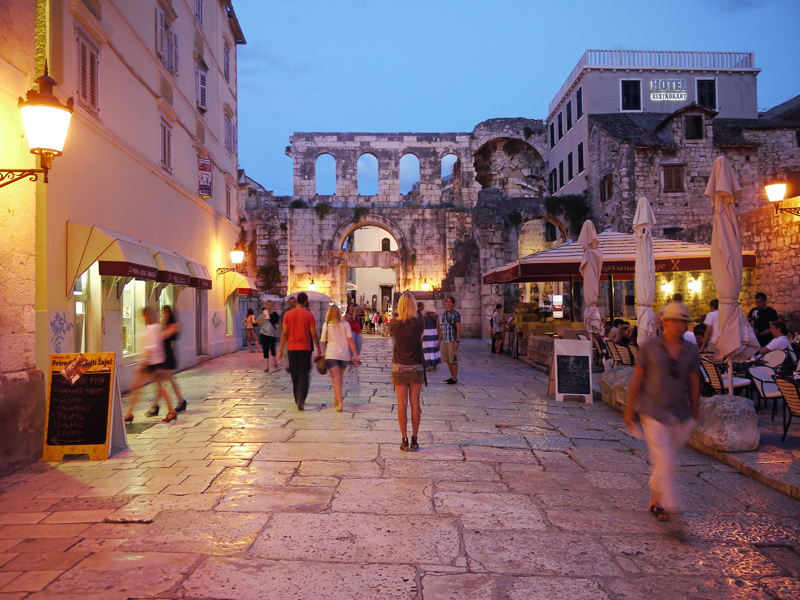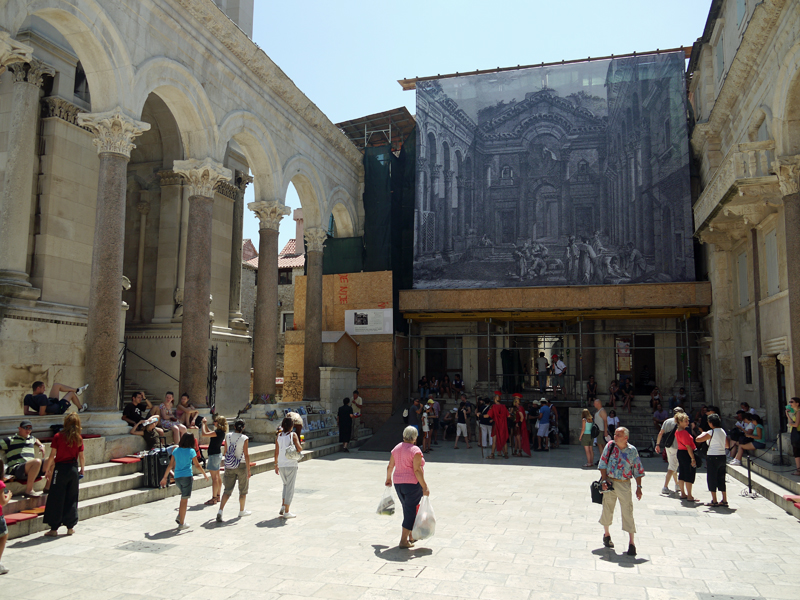Diocletian’s Palace in Split was built between the late 3rd and early 4th centuries AD. It consists of several structures, all of which form part of a UNESCO heritage protected area. The Palace is very important to Croatia from a historical point of view, and depicted on the reverse of the Croatian 500 kuna banknote, issued in 1993.
I visited the area twice, hence the mixture of daytime and night time photos. Like most places in the world, the vibe and atmosphere is quite different during the night versus the day, and it’s well worth checking the area out at both times.


The dominating cathedral was built in the Middle Ages, with several Romanesque churches and medieval fortifications built between the 12th and 13th centuries. In the 15th century, Gothic palaces were constructed, and various Renaissance and Baroque palaces were also constructed.
In the early Middle Ages, the entirety of Split was contained within the walls of the Palace, and it was only in the 14th century, during a period of great prosperity, that the town expanded.
All of the grander buildings, the religious buildings, royal apartments and the like, were contained in the southern half of the Palace, with residences for servants and soldiers and storage areas contained in the northern half.


Diocletian’s Palace is of notable importance due to the fact that it is the most well preserved ancient buildings on the Croatian side of the Adriatic coast, and one of the most intact examples of a complete Roman palace. The Palace’s form and the arrangement of the buildings within the palace represent a transitional style of imperial villa, Hellenistic town and Roman camp.
On the eastern side of the Palace is the Porta Argentea (Silver Gate). Reconstructed between 1932-1934, the gate gives access to the Plain of King Tomislav and to the Peristil (peristyle), the central open-air area of the palace.




There is a small market underneath Diocletian’s Palace that contains the usual bric-a-brac that you find in tourist towns. The architecture itself is what I was more interested in down here, however saying that, you could do worse than here if you wanted to get yourself a memento from Split – beyond the usual touristy stuff there are some quality artisan goods for sale.
Does this sort of stuff need to be sold in the Palace itself? From a business point of view, it clearly makes sense but I know I’d much rather have seen something educational and informative in this space instead.

In the eastern part of the Peristil is the Mausoleum of Diocletian (today’s Cathedral of St Doimus dedicated to St Mary). This is a beautiful building with an amazingly intact interior. It almost completely retains its original octagonal form, encircled by 24 columns which once supported the roof. The dome roof used to contain mosaics, but unfortunately these were lost long ago.









Across from the Mausoleum is a small temple, that was built in dedication of Jupiter. Not much of the temple remains, and two other small temples that were located here no longer stand.

From the seemingly unassuming “back” of Diolcetian’s Palace, you get quite an interesting view of the area, and where the ruins of old and the lives of the new meet.



Leaving Diocletian’s Palace from the south takes you to the boardwalk and the coast. This area is vibrant well into the night during the summer, and it’s a great spot for chilling out and watching the world go by, with a beautiful view of the Adriatic.




Even if you didn’t know the exact details behind the importance of Diocletian’s Palace (as I didn’t when I first visited) you can tell that it’s something special. Walking through the Palace you can feel the history of the area. You start to think about empires, wars and the fluidity of power of the long history of this part of the world and relate it to various things that are happening in the world today.
Visiting Diocletian’s Palace makes you want to learn more – and anything that invokes a thirst for knowledge is worth protecting for that reason alone.

